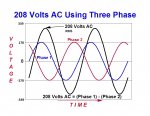Russs57
Senior Member
- Location
- Miami, Florida, USA
- Occupation
- Maintenance Engineer
I always try to understand other people's point of views.
With that in mind let me ask the following. Say you have a complex, non-periodic waveform. Yet say over a half cycle it might be close to periodic. Now if we break it down with Fourier transformation to individual sine waves, and phase shift them by 180 degrees, and then sum them back together......well are we back to 180 = -1?
This might be worth playing around with. Haven't had a chance yet myself.
https://www.desmos.com/calculator/cktkoo3hex
With that in mind let me ask the following. Say you have a complex, non-periodic waveform. Yet say over a half cycle it might be close to periodic. Now if we break it down with Fourier transformation to individual sine waves, and phase shift them by 180 degrees, and then sum them back together......well are we back to 180 = -1?
This might be worth playing around with. Haven't had a chance yet myself.
https://www.desmos.com/calculator/cktkoo3hex




